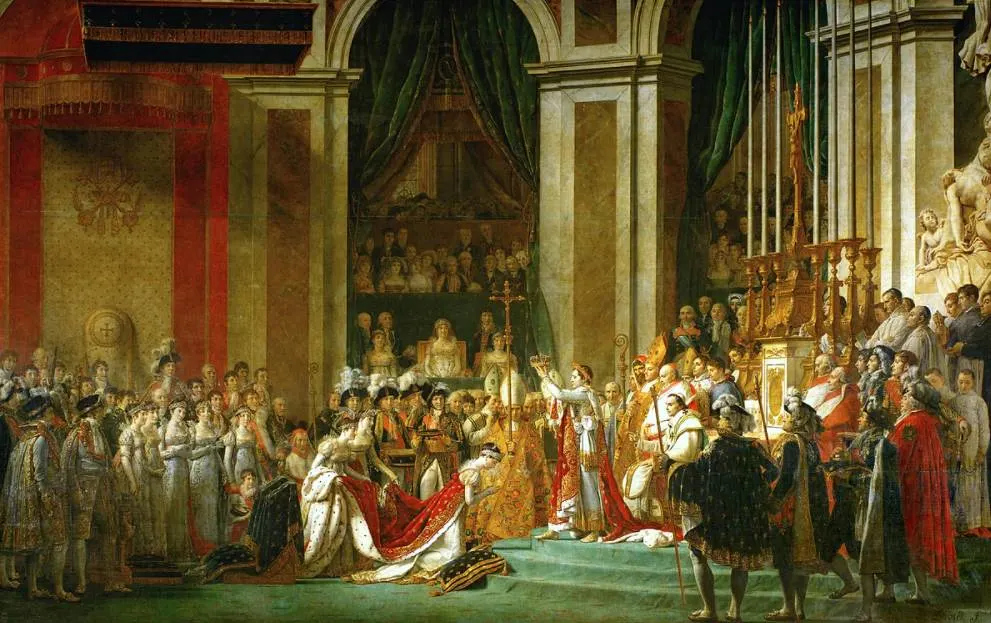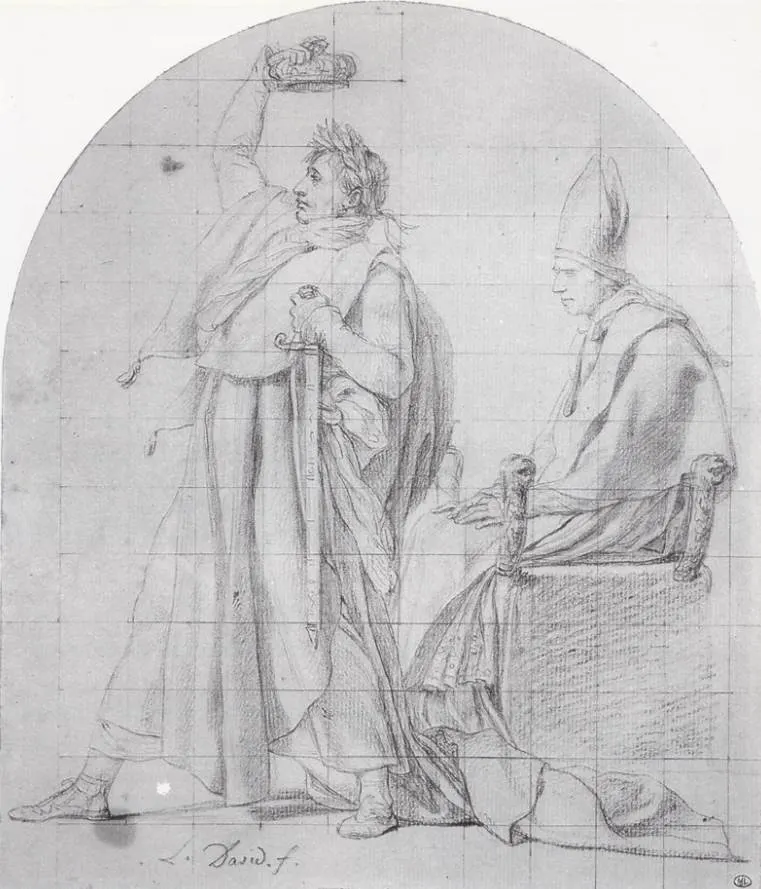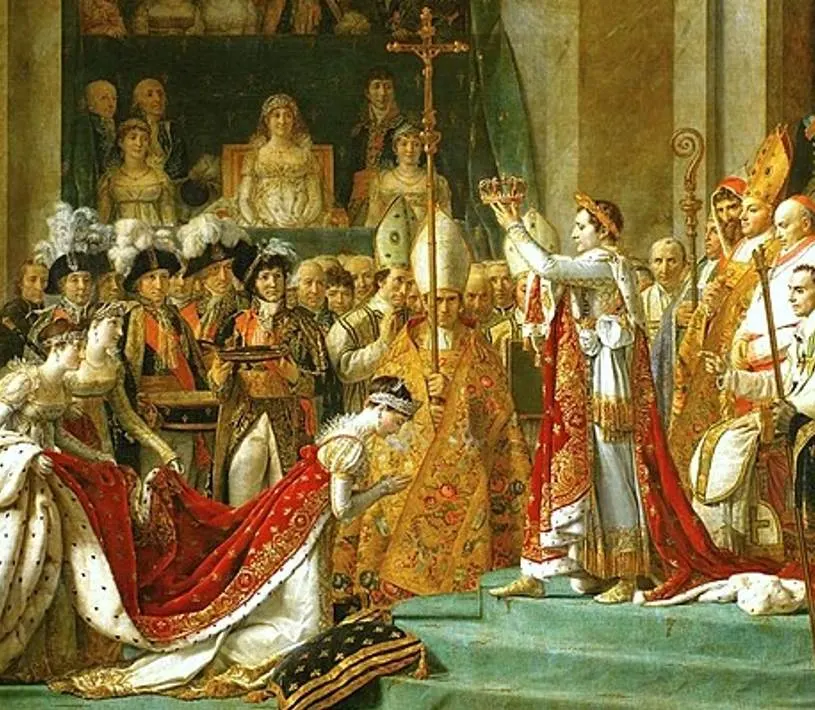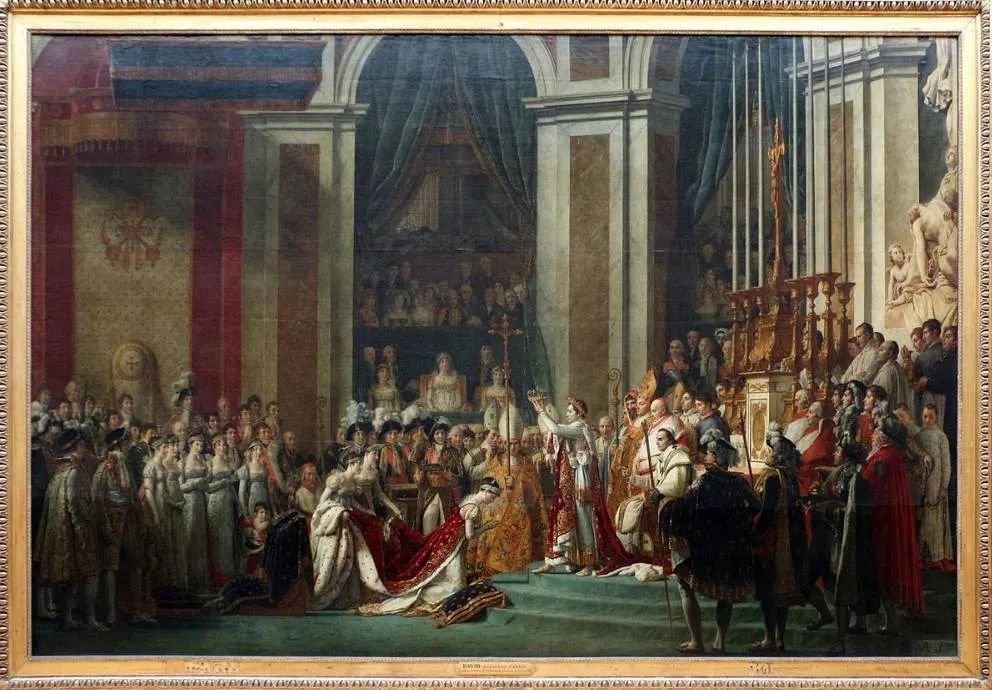The leading Neoclassical artist of his time was partially responsible for the transition of frivolous Rococo art to austere Neoclassical art.
This radical shift in taste happened at the same time that big political changes happened in France, including the start of the French Revolution and the toppling of the monarchy.
Jacques-Louis David (1748-1825) first swore loyalty to the revolutionaries and then became a fervent follower of Napoleon Bonaparte.
His enormous talent eventually earned him the honor of becoming the personal painter of the French Emperor during his reign. The result was an exile to Brussels after Napoleon’s Fall.
In this article, you’ll discover some of the most interesting facts about The Coronation of Napoleon, one of David’s ultimate masterpieces.
1. It took over 2 years to complete the painting in the early 19th century
The Coronation of Napoleon is one of the largest oil paintings ever produced, a notion that explains why it took the artist over 2 years to complete it.
The painting was commissioned by Napoleon himself in September of 1804. This was a time when Jacques-Louis David was already considered to be the official court painter and personal painter of Napoleon.
He started working on this monumental work of art in December of the year 1804 together with his student Georges Rouget (1783-1869). He only completed it in January of the year 1808.

2. It depicts an event that took place in Paris’ most famous church
The Coronation of Emperor Napoleon and his Empress Josephine took place on December 2, 1804. This was the same month that David started working on the painting. It took place at Notre-Dame Cathedral on the Île de la Cité in central Paris.

Although he took some liberties in this work, he attended this event so it can be considered to be a pretty accurate depiction of what happened that day.
The painting is a prime example of Neoclassical art which focuses on a balanced composition organized around several axes.
Napoleon is in the center of the composition and everybody is looking at him as he holds the crown in front of him.

3. How Napoleon holds the crown was not the artist’s first idea
One of the most remarkable facts about The Coronation of Napoleon by Jacques-Louis David is that he changed his mind as to how he depicted Napoleon.
As usual, he produced a large number of preparatory drawings to ensure the composition remains balanced. This allowed him to make small changes along the way.
David’s original idea was to have Napoleon hold the crown above his head as if he was crowning himself. To avoid this confusion, he slightly changed this detail and had Napoleon hold the crown in front of him.

4. David added multiple famous people who were present (and not present)
The woman sitting on the throne in the background is Maria Letizia Ramolino (1750–1836), Napoleon’s mother. The artist painted her but she was not present because her sons had a dispute with each other at the time.
The brother he was quarreling with at the time was Joseph Bonaparte (1768–1844). He was not invited, but David included him as well on the utmost left side of the painting.
Joséphine de Beauharnais (1763–1814) was Napoleon’s wife and can be seen kneeling in front of her husband which was the tradition.
The leader of the Catholic Church at the time, Pope Pius VII (1742–1823), is the man sitting right behind Napoleon. he was the one who blessed the coronation.
Some other notable people in the crowd are:
- Louis Bonaparte (1778–1846) – The younger brother of Napoleon.
- Napoleon Charles Bonaparte (1802–1807) – The young son of Louis Bonaparte.
- Charles-Francois Lebrun (1739–1824) – An important statesman who holds the scepter.
- Joachim Murat (1767–1815) – The brother-in-law of Napoleon and future King of Naples.

5. It was exhibited at a famous event the year it was completed
The painting was an instant success because of the accurate depiction of various important people and the colossal size of this artwork.
It went on display just a month after Jacques-Lous David put the final touches to it as it was displayed at the Paris Salon of 1808.
This prestigious art exhibition took place between February 7 and March 22 of that year and was the Salon’s main attraction that year.
Remarkably, the painting remained in the artist’s collection until 1819, the time that he exiled himself to Brussels after the Fall of Napoleon.

6. The painting appeared in another work that was completed in 1810
The Paris Salon of 1808 wasn’t the only event that the painting was displayed shortly after it was completed. The Coronation of Napoleon was displayed 3 times between 1808 and 1810 at the Louvre Museum in Paris.
The museum had been renamed the “Musée Napoléon” in 1803 so it became a major attraction here as well during these exhibitions.
It also inspired other artists. One of David’s colleagues, a French artist named Louis Léopold Boilly (1761-1845), produced a work in 1810 titled “The Public Viewing David’s “Coronation” at the Louvre.”
This painting depicts people admiring the work during one of these exhibitions. Printed guidebooks were given to the people so they could see who was present in the painting.
This artwork is part of the collection of the MET in New York City.

7. How big is The Coronation of Napoleon by Jacques-Louis David?
The largest oil on canvas painting ever produced is located in the main room of the Doge’s Palace in Venice. Il Paradiso by Tintoretto has dimensions of 9.1 x 22.6 meters (29.9 x 74.1 feet).
The Coronation of Napoleon by Jacques-Louis David isn’t quite as big. It’s still a monumental work of art that has dimensions of 6.21 × 9.79 meters (20 feet 4 inches × 32 feet 1 inch).

8. Where is the painting located today?
The artist still owned the painting until 1819. It was transferred to the Royal Museums after the artist exiled himself to Brussels. After all, how was he going to bring such a huge painting with him, right?
He was also commissioned to paint a replica of the painting in 1808 but only completed it in Brussels in 1822. It’s not a replica because he painted it from memory. This work is now part of the collection of the Palace of Versailles.
The original painting also resided at the Palace of Versailles in the 19th century until it was transferred to the Louvre Museum in 1889.
The painting is still part of the amazing collection of paintings at the Louvre today.

